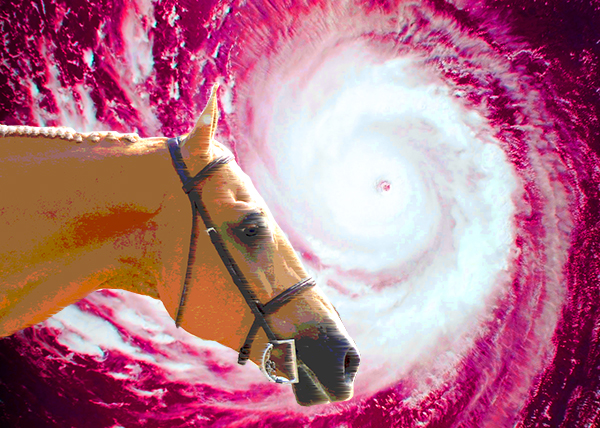Horses and Hurricanes
 By: DIY Equestrian/Michelle Axmaker
By: DIY Equestrian/Michelle Axmaker
In the wake of Hurricane Harvey in Texas, now is probably a good time to go over Natural Disaster Preparedness. Better late than never, right?
I feel confident I can write a good article here. My ranch is near San Antonio, Texas, and I was originally in Hurricane Harvey’s path. Thankfully, it changed course, and we faired very well. I also weathered Hurricanes Francis and Jeanne on the Florida coast. I have experience with big storms.
To evacuate or not? In the case of hurricanes, we usually have a few days notice if we will be in the projected path. (And of course, that’s subject to change).
The first decision to make is whether or not to evacuate. If you can leave, it’s important to remember that possibly thousands of others will be on the road with you. You will need to bring extra fuel with you, as many people run out while sitting in gridlock traffic for hours and hours. Fuel becomes hard to find in the days before a storm hits. You will need to make arrangements to board your horse for several weeks in an area away from the storm. It’s often a week or more before residents are allowed to return to disaster areas. Pack feed, hay, and medications accordingly. You also need to have your horse’s Coggins and important papers with you. Pack that trailer with your valuable horse gear like saddles. Anything left behind is subject to water damage and theft by looters. Once you are safely evacuated, sit back and stay glued to the weather channel. Do not attempt to return home until local authorities say it’s ok. You may need documents such as a driver’s license to get back into your neighborhood.
In many cases, evacuation simply isn’t an option. Maybe you don’t have a horse trailer, or maybe you have more horses than slots in your trailer. In my case, I wasn’t able to evacuate Florida because I had to work before, during and after the storms. I guess I was considered essential personnel, as I was a zookeeper. Much like horsemen, zookeepers are on duty 24/7, rain or shine. So, perhaps your job is keeping you in the storm path or there’s simply no place to safely evacuate to. There are so many reasons why evacuation may not be possible. I understand that and pass no judgement to those who hunker down and weather the storm. Be prepared for a LOT of work in the days prior and after. Be ready for STRESS, STRESS, and STRESS. But most importantly, be prepared…
Stock up what you can. Hay and grain is going to be hard to come by. You want to get as much as you can to last you at least two weeks. Even when the storm settles, getting supplies is difficult. Feed stores may not be open and you may not even be able to get to them. Storage is key. You need to keep your hay and grain somewhere dry. A lot of people stack it on pallets in the garage, the guest bathroom, or wrap it tightly in tarps in the barn/feed room. Make sure you have an emergency box ready to go. Horses will pick the worst time to get cut, and your veterinarian may not be able to get to you for several days. You need to be able to handle any minor injuries on your own. Have an ice chest (or 5) full and ready for your food as well as any refrigerated equine medication.
Stalling depends on your barn. If it’s not rated for a Category 3+ storm and there’s any chance it’s going to lose its roof, turn your horse out. The last thing you want is a horse trapped inside a collapsed barn with no one to help get him out. My horse hunkered down during Francis and Jeanne in a barn built to withstand hurricanes. He got lots of extra hay in his hay bag to keep him occupied, standing bandages just in case he got loose or was frantic in the stall, and a fly mask to protect his eyes from flying debris and dust. I’m happy to report that he only had to deal with a soggy stall and was not washed away. Some barn mates also choose to put earplugs in the horses ears. Hurricanes are extremely loud and this extra precaution can be comforting for some equines.
Try to park your truck and trailer away from trees or structures that may blow away (metal carports). If they fall, you don’t want them on top of your only way to get out. Bring your valuable tack inside or place them up high and cover with plastic sheeting or tarps. Check with your insurance company…. is your saddle covered in case of storm damage? Do you have good photographs of your high dollar tack items?
Electricity and water will be out for days. Fill up a few big water troughs so you can continue to offer fresh/clean water to your horse in the coming days. This is a big one that’s often overlooked. Water is going to be very important and hard to come by, especially in the large amounts that horses require.
Bug spray will be worth its weight in gold. All the bugs will be out and looking for shelter and food. This includes mosquitos, flies, fire ants, roaches and whatever else you can think of. Have fly spray ready for your horse, bug repellent for yourself, and spray for the hoards of ants. Note that wildlife may try to enter your home and barn as well. Be cautious and also understanding of their situation as well. If you come across injured wildlife, contact your local Fish and Game officers, when you can.
Have your rubber boots and lots of fresh socks ready to go. You will basically be living in them for weeks. Baby powder will help keep your feet dry.
If your horse is turned out: Do not leave a halter on him. He could get hung up, especially in a flooding situation. Do not write your phone number on his hooves…. think of the mud that will be caked on his legs and feet. Your best bet is to spray paint your phone number on his body. You may also braid luggage tags into his mane, but keep in mind that they can be removed by bad people or pulled out by debris. Have photos of all sides of your horse with his paperwork in case you need to claim him from a good samaritan or animal shelter. Up close photos of any brands or distinctive markings is also a great idea to have ready.
In a flooding situation, it’s best to move your horse to high ground as quickly as possible. This means you have to enter the floodwater, and that’s dangerous. Be mindful of submerged debris, holes, hazards, and of course the overload of harmful bacteria in the water. Be safe and do what you can to get your horse out of floodwaters. As hard as it is, animal lives should never take precedence over human lives. Do not put yourself in a dangerous situation, ever. Many people die in natural disasters because they knowingly put themselves in harms way. Please don’t risk your life. Horses who endure days stuck in water are often susceptible to skin infection and hoof disease. Prevention is best, but not always possible.
After the storm has passed, sigh a big sigh of relief. You and your horse have survived! Clean up can take weeks or months, but you made it! Having plenty of supplies on hand will make post-storm work much easier and less stressful. Many people will be around to offer assistance and support. Let your family and friends know that you’re safe and let them know of specific items you need. Knowing what to expect and being prepared for anything will make everything easier. Stay safe out there!
For fun and helpful articles, please like my Facebook page, The DIY Equestrian.










